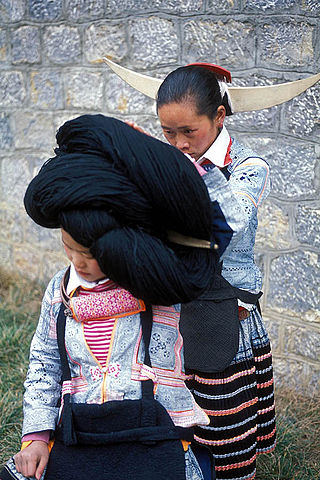Related Research Articles

The Miao are a group of linguistically-related peoples living in Southern China and Southeast Asia, who are recognized by the government of China as one of the 56 official ethnic groups. The Miao live primarily in southern China's mountains, in the provinces of Guizhou, Yunnan, Sichuan, Hubei, Hunan, Guangxi, Guangdong, and Hainan. Some sub-groups of the Miao, most notably the Hmong people, have migrated out of China into Southeast Asia. Following the communist takeover of Laos in 1975, a large group of Hmong refugees resettled in several Western nations, mainly in the United States, France, and Australia.

The Hmong–Mien languages are a highly tonal language family of southern China and northern Southeast Asia. They are spoken in mountainous areas of southern China, including Guizhou, Hunan, Yunnan, Sichuan, Guangxi, and Hubei provinces; the speakers of these languages are predominantly "hill people", in contrast to the neighboring Han Chinese, who have settled the more fertile river valleys.
The Hmu language, also known as Qiandong Miao, Central Miao (中部苗语), East Hmongic, or Black Miao, is a dialect cluster of Hmongic languages of China. The best studied dialect is that of Yǎnghāo (养蒿) village, Taijiang County, Guizhou Province, China.
The She language, autonym Ho Ne, or Ho Nte, is a critically endangered Hmong–Mien language spoken by the She people. Most of the over 709,000 She people today speak Shehua. Those who speak Sheyu—approximately 1,200 individuals in Guangdong Province—call themselves Ho Ne, "mountain people".
Kim Mun language (金门方言) is a Mienic language spoken by 200,000 of the Yao people in the provinces of Guangxi, Hunan and Yunnan, with about 61,000 of the speakers in Hainan Province.
The Iu Mien language is the language spoken by the Iu Mien people in China, Laos, Vietnam, Thailand and, more recently, the United States in diaspora. Like other Mien languages, it is tonal and monosyllabic.

The Hmongic languages, also known as Miao languages, include the various languages spoken by the Miao people. Hmongic languages also include various languages spoken by non-Mienic-speaking Yao people, such as Pa-Hng, Bunu, Jiongnai, Younuo, and others, while She is spoken by ethnic She people.
Proto-Hmong–Mien is the reconstructed ancestor of the Hmong–Mien languages. Lower-level reconstructions include Proto-Hmongic and Proto-Mienic.
Pa-Hng is a divergent Hmongic (Miao) language spoken in Guizhou, Guangxi, and Hunan in southern China as well as northern Vietnam.
The Bu–Nao or Bunu languages are a Hmongic (Miao) language branch spoken in Guangxi, Yunnan, and Guizhou in China. Its speakers are officially classified as ethnic Yao but speak Hmongic languages. The branch consists of three languages, which are Bunu, Baonao, and Numao. The term Bu–Nao is a portmanteau of Bunu and Nao Klao.
Kiong Nai is a divergent Hmongic (Miao) language spoken in Jinxiu County, Guangxi, China. The speakers' autonym is pronounced or ; means 'mountain', while means 'people'. Mao & Li (2002) believe it to be most closely related to She.
Younuo is a divergent Hmongic language spoken in Longsheng Various Nationalities Autonomous County, Guangxi, China. Mao (2007:129) reports a total of approximately 4,000 speakers.

The Mienic or Yao languages are spoken by the Yao people of China, Vietnam, Laos, and Thailand.
The Xong language is the northernmost Hmongic language, spoken in south-central China by around 0.9 million people. It is called Xiangxi Miaoyu in Chinese, as well as Eastern Miao (东部苗语). Western sources, it has been called Meo, Red Miao, and North Hmongic. An official alphabet was adopted in 1956.
The A-Hmao language, also known as Large Flowery Miao or Northeast Yunnan Miao, is a Hmongic language spoken in China. It is the language the Pollard script was designed for, and displays extensive tone sandhi. There is a high degree of literacy in Pollard among the older generation.
The West Hmongic languages, also known as Chuanqiandian Miao and Western Miao, are a major branch of the Hmongic languages of China and Southeast Asia.
Hm Nai is a Hmong-Mien language spoken in western Hunan province, China. There are approximately 5800 people speaking this language, and the number is decreasing. Mao & Li (1997) determined it to be closely related to the Pa-Hng language.
Pingtang Miao, named after Pingtang County in which it is spoken, is a group of Miao language varieties of China.
Raojia is a Hmongic language spoken by about 5,000 people in 3 villages of Heba Township 河坝乡, Majiang County, Guizhou.
The Sheic or She–Jiongnai languages are a branch of the Miao (Hmongic) language family.